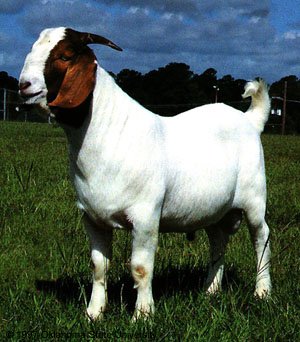Boer
Also Known by: Africander, Afrikaner, South African common goat
The Boer is an improved indigenous breed with some infusion of European, Angora and Indian goat breeding many years ago. Several researchers agree that the indigenous populations were probably from the Namaqua Hottentots and from southward migrating Bantu tribes. The name is derived from the Dutch word "boer" meaning farmer and was probably used to distinguish the native goats from the Angora goats which were imported into South Africa during the 19th century. The present day Boer goat appeared in the early 1900's when ranchers in the Easter Cape Province started selecting for a meat type goat.
The South African registry was established in 1959. Since 1970 the Boer goat has been incorporated into the National Mutton Sheep and Goat Performance Testing Scheme making it the first goat breed involved in meat production performance testing.
The Boer goat is primarily a meat goat with several adaptations to the region in which it was developed. It is a horned breed with lop ears and showing a variety of color patterns. The Boer goat is being used very effectively in South Africa in combination with cattle due to its browsing ability and limited impact on the grass cover. Producing weaning rates in excess of 160% the Boer goat doe is a low maintenance animal that has sufficient milk to rear a kid that is early maturing. The mature Boer Goat ram weighs between 110-135 kg (~240-300 lbs) and ewes between 90 and 100 kg (~200-225 lbs).
Performance records for this breed indicate exceptional individuals are capable of average daily gains over 0.44 lb/day (200 g/day) in feedlot. More standard performance would be 0.3-0.4 lbs/day (150-170 g/day). The ovulation rate for Boer goats ranges from 1 to 4 eggs/doe with an average of 1.7. A kidding rate of 200% is common for this breed. Puberty is reached early, ususally about 6 months for the males and 10-12 months for the females. The Boer goat also has an extended breeding season making possible 3 kiddings every 2 years.
Common Use
The Boer goat was selectively improved for its meat production ability and its
ability to pass on that trait to its offspring along with other traits including pasture
hardiness. With an addition of a Boer buck to a commercial meat goat herd the meat
characteristics of the offspring can be drastictly improved without making them too
"soft" to be pasture goats. These goats imfamous for rapid weight gain and heavy
muscling and have a high fertility.
Feeding Habits
Boer goats prefer to browse rather than to graze, and prefer many plants other
goats will not touch, including most weeds, gorse, briar, shrubs, tree leaves,
blackberries, and various woody species. Goats don't eat everything as usually thought.
They are very choosy about their food, but they are able to select from a wider variety of
plants than any other livestock. For this reason they are able to survive a lot better on
poorer pasture, and even drought. Their diets overlap with other livestock however, and
they will compete for food.
Fecundity and
Fertility
Boer goat does can breed at 10 months old and usually produce twins with
occasionally triplets or singles although quads and occasionally quins also occur. Boer
bucks are very vigorous and can be fertile from as early as 4 months and if not weaned by
this time they may join with their mothers. Growth rates of kids are exceptional during
the first 12 months, with average daily weight gains from 200 to 250grams a day. A mature
animal will weigh up to 130kgs and has a breeding life of 10 years.
Milk
Production
Under natural conditions, milk production is a main part of reproduction. In
the Boer goats case they have no milk producing reputation since they have not been
selected for this trait. Unimproved Boer goats can be milked to provide food in rural
subsistance farming. This is done under extensive, semi-hardy veld conditions. Boer goat
does, (2-6 teeth in age), with singles to triplets commonly have average daily milk
productions of 1.5-2.5 kg. This range is due to litter size and lactation number.
Breed Associations and Registries
Reference:
Brochure, American Boer Goat Association
Brochure, Select Genes Ltd., PO Box 494, Irene 1675, Republic of South Africa. Phone: -27-12-6671129 Fax: -27-12-6671827
Mason, I.L. 1988. World Dictionary of Livestock Breeds. Third Edition. C.A.B International. 348 pp.
Photographs:
American Boer Goat Association
